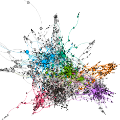Values (why to conserve) and Attributes (what to conserve) are essential concepts of cultural heritage. Recent studies have been using social media to map values and attributes conveyed by public to cultural heritage. However, it is rare to connect heterogeneous modalities of images, texts, geo-locations, timestamps, and social network structures to mine the semantic and structural characteristics therein. This study presents a methodological workflow for constructing such multi-modal datasets using posts and images on Flickr for graph-based machine learning (ML) tasks concerning heritage values and attributes. After data pre-processing using state-of-the-art ML models, the multi-modal information of visual contents and textual semantics are modelled as node features and labels, while their social relationships and spatiotemporal contexts are modelled as links in Multi-Graphs. The workflow is tested in three cities containing UNESCO World Heritage properties - Amsterdam, Suzhou, and Venice, which yielded datasets with high consistency for semi-supervised learning tasks. The entire process is formally described with mathematical notations, ready to be applied in provisional tasks both as ML problems with technical relevance and as urban/heritage study questions with societal interests. This study could also benefit the understanding and mapping of heritage values and attributes for future research in global cases, aiming at inclusive heritage management practices.
翻译:文化遗产的基本概念是价值(为何保存)和属性(何以保存),这些是文化遗产的基本概念。最近的研究利用社交媒体绘制公众向文化遗产传递的价值和属性。然而,将图像、文本、地理定位、时间戳和社会网络结构的不同模式与其中的语义和结构特征联系起来,是很少见的。本研究为利用Flickr上基于图表的机器学习(ML)任务与遗产价值和属性有关的图象进行多模式数据集的构建提供了一个方法工作流程。在使用最新ML模型进行数据预处理后,视觉内容和文字语义的多模式信息以节点特征和标签为模范,而其社会关系和时空环境则以多格的链接为模范。该工作流程在三个城市(阿姆斯特丹、苏州和威尼斯)进行了测试,这些城市遗产特性生成了与半超强的学习任务高度一致的数据集。整个过程都正式描述数学注释,准备在临时任务中应用,作为节点特征,作为ML的特征,作为多格研究的参考,并研究研究研究,并研究城市遗产的课题研究。





